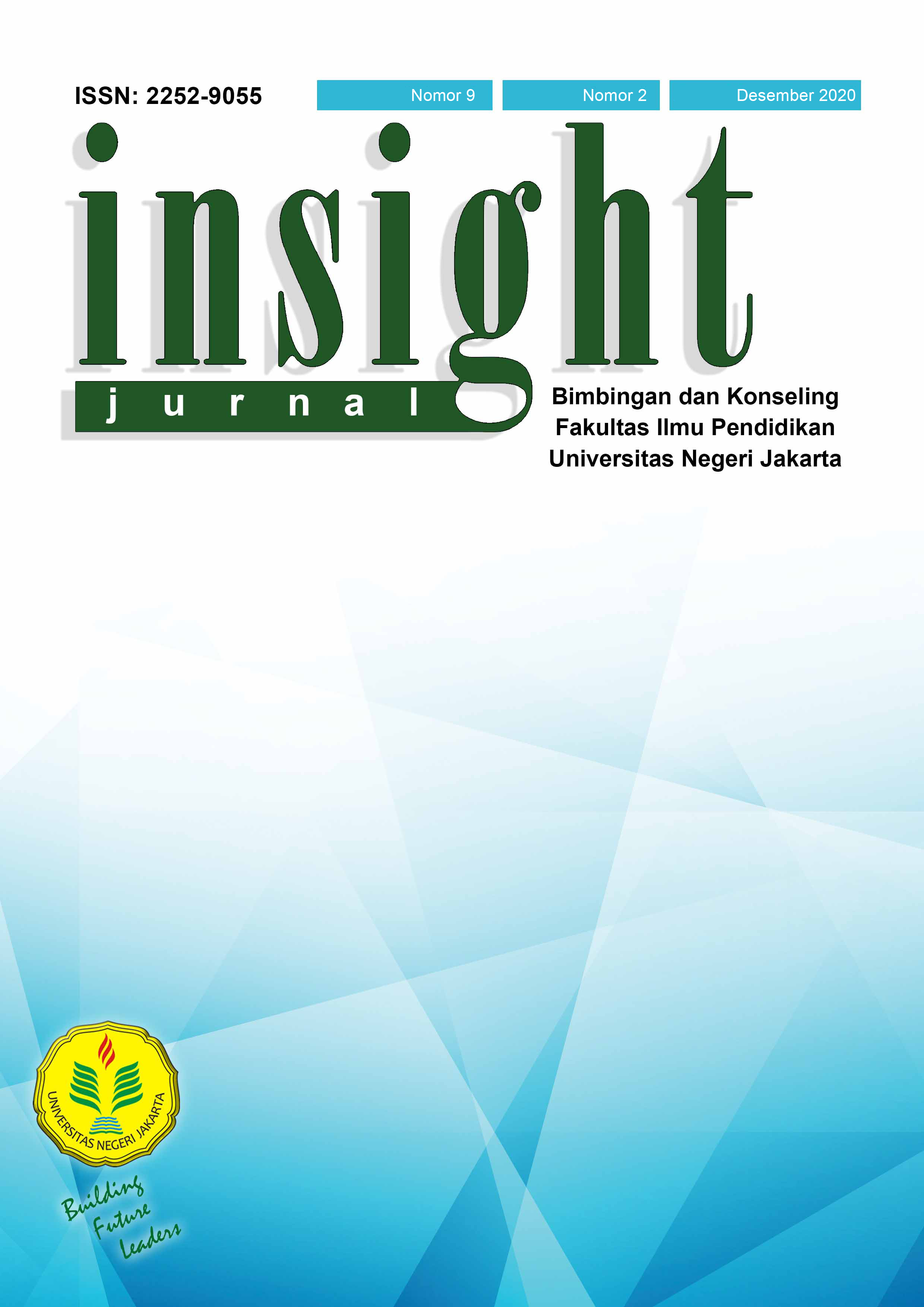Difusi Kognitif Remaja: Kebutuhan Video Tutorial Latihan Difusi Kognitif
DOI:
https://doi.org/10.21009/INSIGHT.092.06Keywords:
Difusi Kognitif, Fusi KognitifAbstract
Abstrak
Penelitian ini bertujuan untuk mempelajari tingkat fusi kognitif remaja dan alat yang sesuai untuk memfasilitasi latihan difusi kognitif. Convenience sampling digunakan untuk mengumpulkan data dari 199 peserta didik. Instrumen yang digunakan adalah Cognitive Fusion Questionnaire (CFQ-7). Hasil penelitian menunjukkan bahwa 60% remaja mengalami fusi kognitif tinggi (m = 29). Hasil tingkat fusi berdasarkan jenis kelamin, perempuan memiliki tingkat fusi yang lebih tinggi dibandingkan laki-laki (30 vs 28). Persentase perempuan yang mengalami fusi tingkat tinggi melebihi jumlah laki-laki (53% vs 42%). Hasil tingkat fusi berdasarkan sosial ekonomi, tingkat sosial ekonomi rendah memiliki tingkat fusi yang lebih tinggi dibandingkan sosial ekonomi tinggi (34 vs 29). Persentase sosial ekonomi rendah yang mengalami fusi tingkat tinggi melebihi jumlah sosial ekonomi tinggi (75% vs 48%). Sebagian besar peserta didik memiliki eksposur terbatas pada latihan difusi kognitif (-70%) dan semuanya ingin belajar latihan difusi kognitif melalui video. Direkomendasikan bahwa video latihan difusi kognitif dibutuhkan untuk membantu peserta didik dalam meningkatkan kemampuan difusi kognitifnya.
Kata Kunci: Difusi Kognitif, Fusi Kognitif
Abstract
This study aims to explore the level of adolescents’ cognitive fusion and suitable tools to facilitate cognitive defusion exercise. The convenience sampling used to gather the data from 199 students. The instrument used are the Cognitive Fusion Questionnaire (CFQ-7). The results showed that 60% of adolescents experienced high cognitive fusion (m = 29). The result of fusion level based on gender, female has higher level fusion than male (30 vs 28). The percentage of female who experience high level fusion was outnumber male (53% vs 42%). The result of fusion level based on sosial economy, low social economy higher level fusion than high social economy (34 vs 29). The percentage of low social economy who experience high level fusion was outnumber high social economy (75% vs 48%). Most of student has limited exposure to cognitive diffusion exercises (-70%) and all of them eager to learn cognitive defusion exercises through video. It is recommended that cognitive defusion exercise video is needed to help student increase their cognitive defusion skill.
Keyword: Cognitive Defusion, Cognitive Fusion
References
Brown, F. J., & Gillard, D. (2016). Acceptance and commitment therapy for dummies. John Wiley & Sons, Ltd.
Dempster, M. A. (2009). Development and initial validation of a scale to measure cognitive fusion. PQDT - UK & Ireland, February, 1. https://search.proquest.com/docview/1040635056?accountid=14166%0Ahttp://xg9ax2jm9j.search.serialssolutions.com?ctx_ver=Z39.88-2004&ctx_enc=info:ofi/enc:UTF-8&rfr_id=info:sid/ProQuest+Dissertations+%26+Theses+Global&rft_val_fmt=info:ofi/fmt:kev:mtx:dissert
Dinis, A., Carvalho, S. A., Pinto Gouveia, J., & Estanqueiro, C. (2015). Shame memories and depression symptoms: The role of cognitive fusion and experiential avoidance. International Journal of Psychology and Psychological Therapy, 15(1), 63–86.
Gillanders, D. T., Bolderston, H., Bond, F. W., Dempster, M., Flaxman, P. E., Campbell, L., Kerr, S., Tansey, L., Noel, P., Ferenbach, C., Masley, S., Roach, L., Lloyd, J., May, L., Clarke, S., & Remington, B. (2014). The Development and Initial Validation of the Cognitive Fusion Questionnaire. Behavior Therapy, 45(1), 83–101. https://doi.org/10.1016/j.beth.2013.09.001
Hambleton, R. K., Merenda, P. F., & Spielberger, C. D. (2005). Adapting Educational and Psychological Tests for Cross-Cultural Assessment. Lawrence Erlbaum Associates Publishers.
Harris, R. (2009). ACT made imple : an easy-to-read primer on acceptance and commitment therapy. New Harbinger Publications. papers2://publication/uuid/464225D2-A6DA-4034-ACFB-179650B573C3
Harris, Russell. (2006). Embracing your demons: An overview of acceptance and commitment therapy. Psychotherapy in Australia, 12(4), 2–8.
Hayes, S. C. (2005). Get out of your mind and into ypur life: The new acceptance and commitment therapy. New Harbinger Publications.
Hayes, S. C., Luoma, J., Bond, F. W., Masuda, A., & Lillis, J. (2006). Acceptance and commitment therapy: Model, processes, and outcomes. Psychology Faculty Publications, 1–30. https://doi.org/10.4324/9781315745138
Healy, H. A., Barnes-Holmes, Y., Barnes-Holmes, D., Keogh, C., Luciano, C., & Wilson, K. (2008). An experimental test of a cognitive defusion exercise: Coping with negative and positive self-statements. Psychological Record, 58(4), 623–640. https://doi.org/10.1007/BF03395641
Hinton, M. J., & Gaynor, S. T. (2010). Cognitive defusion for psychological distress, dysphoria, and low self-esteem: A randomized technique evaluation trial of vocalizing strategies. International Journal of Behavioral Consultation and Therapy, 6(3), 164–185. https://doi.org/10.1037/h0100906
Luoma, J. B., & Hayes, S. C. (2003). Cognitive Defusion. In W. O’Donohue, J. E. Fisher, & S. C. Hayes (Eds.), Cognitive behavior therapy: applying empirically supported techniques in your practice. John Wiley & Sons. https://doi.org/10.1201/9781315380797
Mandavia, A., Masuda, A., Moore, M., Mendoza, H., Donati, M. R., & Cohen, L. L. (2015). The application of a cognitive defusion technique to negative body image thoughts: A preliminary analogue investigation. Journal of Contextual Behavioral Science, 4(2), 86–95. https://doi.org/10.1016/j.jcbs.2015.02.003
Masuda, A., Hayes, S. C., Sackett, C. F., & Twohig, M. P. (2004). Cognitive defusion and self-relevant negative thoughts: Examining the impact of a ninety year old technique. Behaviour Research and Therapy, 42(4), 477–485. https://doi.org/10.1016/j.brat.2003.10.008
Saputra, W. N. E., & Prasetiawan, H. (2018). Meningkatkan percaya diri siswa melalui teknik cognitive defusion. Jurnal Kajian Bimbingan Dan Konseling, 3(1), 14–21. https://doi.org/10.17977/um001v3i12018p014
Sasmita, P. E. (2015). Irrational beliefs dalam konteks kehidupan seminari. Jurnal Teologi, 04(01), 25–40.
Sinthia, R. (2011). Hubungan Antara Penerimaan Sosial Kelompok Kelas Dengan Kepercayaan Diri Pada Siswa Kelas I Sltp Xxx Jakarta. Jurnal Kependidikan Triadik, 14(1), 37–44.
Webster, M. (2011). Introduction to acceptance and commitment therapy. Advances in Psychiatric Treatment, 17(4), 309–316. https://doi.org/10.1192/apt.bp.107.005256
Downloads
Published
Issue
Section
License
Authors who publish with this Journal agree to the following terms:
- Author retain copyright and grant the journal right of first publication with the work simultaneously licensed under a creative commons attribution licensethat allow others to share the work within an acknowledgement of the work’s authorship and initial publication of this journal.
- Authors are able to enter into separate, additional contractual arrangementfor the non-exclusive distribution of the journal’s published version of the work (e.g. acknowledgement of its initial publication in this journal).
- Authors are permitted and encouraged to post their work online(e.g. in institutional repositories or on their websites) prior to and during the submission process, as it can lead to productive exchanges, as well as earlier and greater citation of published works.
Users/public use of this website will be licensed to CC BY







